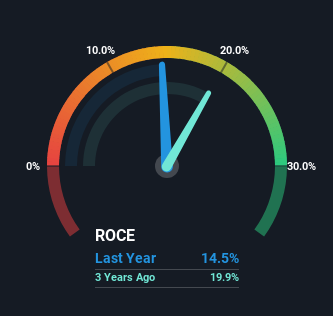- United States
- /
- Consumer Durables
- /
- NYSE:HBB
There Are Reasons To Feel Uneasy About Hamilton Beach Brands Holding's (NYSE:HBB) Returns On Capital

If we want to find a potential multi-bagger, often there are underlying trends that can provide clues. Ideally, a business will show two trends; firstly a growing return on capital employed (ROCE) and secondly, an increasing amount of capital employed. Ultimately, this demonstrates that it's a business that is reinvesting profits at increasing rates of return. In light of that, when we looked at Hamilton Beach Brands Holding (NYSE:HBB) and its ROCE trend, we weren't exactly thrilled.
Understanding Return On Capital Employed (ROCE)
For those who don't know, ROCE is a measure of a company's yearly pre-tax profit (its return), relative to the capital employed in the business. The formula for this calculation on Hamilton Beach Brands Holding is:
Return on Capital Employed = Earnings Before Interest and Tax (EBIT) ÷ (Total Assets - Current Liabilities)
0.15 = US$36m ÷ (US$385m - US$140m) (Based on the trailing twelve months to December 2023).
So, Hamilton Beach Brands Holding has an ROCE of 15%. In absolute terms, that's a pretty normal return, and it's somewhat close to the Consumer Durables industry average of 14%.
View our latest analysis for Hamilton Beach Brands Holding

While the past is not representative of the future, it can be helpful to know how a company has performed historically, which is why we have this chart above. If you'd like to look at how Hamilton Beach Brands Holding has performed in the past in other metrics, you can view this free graph of Hamilton Beach Brands Holding's past earnings, revenue and cash flow.
What Can We Tell From Hamilton Beach Brands Holding's ROCE Trend?
When we looked at the ROCE trend at Hamilton Beach Brands Holding, we didn't gain much confidence. Around five years ago the returns on capital were 30%, but since then they've fallen to 15%. Meanwhile, the business is utilizing more capital but this hasn't moved the needle much in terms of sales in the past 12 months, so this could reflect longer term investments. It may take some time before the company starts to see any change in earnings from these investments.
On a side note, Hamilton Beach Brands Holding has done well to pay down its current liabilities to 36% of total assets. That could partly explain why the ROCE has dropped. What's more, this can reduce some aspects of risk to the business because now the company's suppliers or short-term creditors are funding less of its operations. Since the business is basically funding more of its operations with it's own money, you could argue this has made the business less efficient at generating ROCE.
The Bottom Line
Bringing it all together, while we're somewhat encouraged by Hamilton Beach Brands Holding's reinvestment in its own business, we're aware that returns are shrinking. And investors may be recognizing these trends since the stock has only returned a total of 36% to shareholders over the last five years. Therefore, if you're looking for a multi-bagger, we'd propose looking at other options.
Hamilton Beach Brands Holding does come with some risks though, we found 2 warning signs in our investment analysis, and 1 of those shouldn't be ignored...
For those who like to invest in solid companies, check out this free list of companies with solid balance sheets and high returns on equity.
Valuation is complex, but we're here to simplify it.
Discover if Hamilton Beach Brands Holding might be undervalued or overvalued with our detailed analysis, featuring fair value estimates, potential risks, dividends, insider trades, and its financial condition.
Access Free AnalysisHave feedback on this article? Concerned about the content? Get in touch with us directly. Alternatively, email editorial-team (at) simplywallst.com.
This article by Simply Wall St is general in nature. We provide commentary based on historical data and analyst forecasts only using an unbiased methodology and our articles are not intended to be financial advice. It does not constitute a recommendation to buy or sell any stock, and does not take account of your objectives, or your financial situation. We aim to bring you long-term focused analysis driven by fundamental data. Note that our analysis may not factor in the latest price-sensitive company announcements or qualitative material. Simply Wall St has no position in any stocks mentioned.
About NYSE:HBB
Hamilton Beach Brands Holding
Designs, markets, and distributes small electric household and specialty housewares appliances in the United States and internationally.
Flawless balance sheet with solid track record.
Similar Companies
Market Insights
Community Narratives




